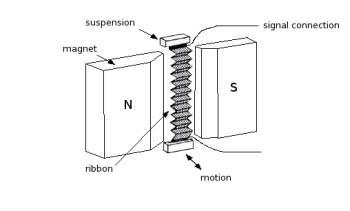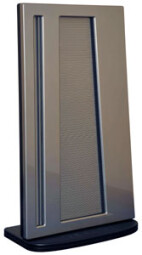In the previous article we discussed compression drivers and acoustic horns. Today we'll focus on a technology whose patent was issued in the 1920s and widely used for microphones. However, its usability for loudspeaker design remained questionable up until the 1950s, when some improvements allowed ribbon speakers to be successfully marketed.
Ribbon speakers

These speakers are based on the same principle as cone speakers, i.e. the interaction of the magnetic field of a magnet with that of a wire through which the signal coming from the amp passes. However, the wire is not coiled around a cylinder extending from the diaphragm. The diaphragm itself is the signal conductor, taking the form of a rectangle held by two of its sides. The electronic circuit is drawn on top, trying to spread it as evenly as possible so that the magnetic force is uniform. The fact that the voice coil and the diaphragm are combined in a single piece makes the moving section lighter, thus avoiding, at least in theory, the displacement of the diaphragm. The conductor is spread across the entire surface, exercising a more homogeneous motive power than a voice coil which has to drive a cone at one end.
Characteristics

com]
The lightness of the ribbon, often made of aluminum, allows it to move very fast. Its transient response is good and its frequency range often goes well beyond 20 kHz. However, its small size and light weight don’t withstand heat too well, which limits power handling. Ribbon drivers are usually used for high-mid and high frequencies, even though you can nowadays find some full-range models out there. Finally, the impedance of the ribbon is very low, which requires the use of an additional transformer ─ a potential source for signal degradation ─ for the amp to work correctly.
The width of the diaphragm must be low, otherwise the air gap will be too big for the magnetic field to be strong enough. It is already larger than that of a moving coil speaker, meaning it requires the use of larger or more powerful magnets to hold an equivalent magnetic field. And since magnets are expensive, so are ribbon speakers. On the other hand, the narrowness of the ribbon provides a much higher directivity in the horizontal plane.
Besides the size of the air gap, there’s another factor that can compromise the speaker’s efficiency: it’s not hard for the ribbon to have acoustic leaks. Since the ribbon is only held by two of its sides (the other two must remain free in order for it to be able to move), the the back wave could eventually short-circuit the front wave if it’s not appropriately absorbed.
Despite their fragility and high cost, ribbon speakers have won over a large community of hi-fi enthusiasts due to their qualities in terms of frequency response, directivity and transient response. Moving coil speakers are usually preferred when you know they will be exposed to harsh conditions or you need a higher efficiency.

com]
With the next article dedicated to more uncommon models we’ll close the chapter dedicated to electrodynamic speakers. And then we’ll move on to other types of transducers.
